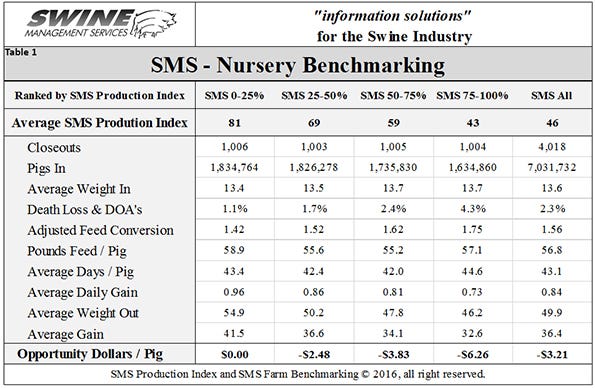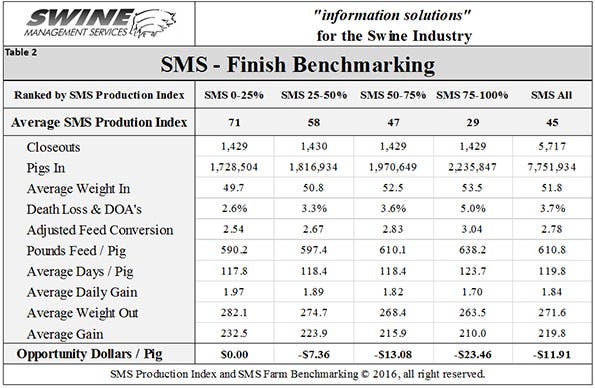Producers can take steps all along in their hog production system to help them survive in a downward cycle in the hog market.

Budgets of hog producers will be getting tighter as hog prices are on the decline, but there are things you can do that do not cost anything and will improve your bottom line.
Sow farm (for a 2,000-sow farm)
Biosecurity
A mild porcine reproductive and respiratory syndrome or porcine epidemic diarrhea virus break will cost $100 per sow in lost income and higher expenses. 2,000 sows x $100 = $200,000
A severe PRRS or PEDV break will cost $400-plus per sow in lost income and higher expenses. 2,000 sows x $400-plus = $800,000-plus
Farrowing rate improvement from 80% to 90% farrowing rate will save $9,100 in semen cost per year.
More than one more pig weaned per mated female per year will reduce the breakeven $1.50 to $2 per pig. This will generate $60,000 to $80,000 per year.
It costs $1.50 to $2 to house a sow for each day. Reducing non-productive days by one day per sow would improve the bottom line by $3,000 to $4,000 per year.
Feed wastage: 1 ounce of feed per sow per day is 22.8 tons per year or $4,760 per year.
At Swine Management Services, we have created an SMS Growing Pig Model to compare closeouts. The SMS Model uses death loss and deads on arrival, cull and light weight pigs, average daily gain and adjusted feed conversion to calculate the SMS Production Index for each closeout. We also recalculate each closeout using a standard market price and feed cost so we can compare closeout performance over time to measure changes. The SMS Model also calculates an “opportunity dollars” for each closeout compared the average of the top 25 of the closeout using the SMS Production Index to rank them. There are 4,018 nursery closeouts with 7,031,732 pigs in the database. There are 5,717 finisher closeouts with 7,751,934 pigs in the database.
Nursery (for a 1,200 head closeout)
Biosecurity
A mild disease break with 10% death loss will cost $3,000-$5,000 in lost income and expenses
A severe disease break with 30% death loss will cost $9,000 to $15,000 in lost income and expenses.
Feeding program: change from a three-ration to a four-ration feeding program will save $0.50 to $1 per pig or $600 to $1,200 per closeout.
The top 25% of the closeouts have an adjusted feed conversion of 1.42 and the bottom 25% have an adjusted feed conversion of 1.75 (Table 1). The 0.33 difference would be 13.2 pounds of feed on 40 pounds of gain or $2 per pig and $2,400 for the closeout.
Average daily gain for the top 25% is 0.96 and for the bottom 25% is 0.84. Over a 40-day feeding period, the difference would be 4.8 pounds per pig. This would be $4-$5 in lost income per pig, or $4,800 to $6,000 for the closeout.

Finisher (for a 1,200-head closeout)
Biosecurity
A mild disease break with 10% death loss will cost $5,000-$8,000 in lost income and expenses.
A severe disease break with 30% death loss will cost $15,000 to $24,000 in lost income and expenses.
Feeding program: change from a four-ration to a six-ration feeding program will save $0.50 to $1 per pig or $600 to $1,200 per closeout.
The top 25% of the closeouts have an adjusted feed conversion of 2.54 and the bottom 25% have an adjusted feed conversion of 3.04 (Table 2). The 0.50 difference would 120 pounds of feed on 240 pounds of gain or $9 per pig and $10,800 for the closeout.
Average daily gain for the top 25% is 1.97 and for the Bottom 25% is 1.70. Over a 120-day feeding period the difference would be 32.4 pounds per pig; this would be $15-$20 in lost income per pig or $18,000 to $24,000 for the closeout.

Do you know what your performance is? Do you know where you rank in the swine industry?
The SMS “opportunity dollars” for the average nursery closeouts is $3.21 per pig, or $3,852 per closeout. The bottom 25% has a $6.26 per pig opportunity or $7,512 per closeout.
The SMS “opportunity dollars” for the average finisher closeouts is $11.21 per pig, or $13,452 per closeout. The bottom 25% has a $23.46 per pig opportunity or $28,142 per closeout.
What can you do to improve your performance?
Biosecurity is job No. 1.
Walk all pens daily.
Treat pigs the day they get sick, not three or four days later.
Check waterers daily in all pens.
Check feeders daily in all pens.
Eliminate out-of-feed events.
Check ventilation setting and adjust as the pigs grow.
Change feeding ration at the proper weight, when the last pig reaches the changing weight, not the first pig.
Make sure you are not overcrowding the pens.
We have created an SMS Carcass Model that does a profit and loss on each carcass using a standard market price, adjusted feed conversion based on carcass weight and feed cost per pound. We use this model in our SMS Carcass and Loading Evaluation program. The program is modified for each packer’s pricing grid. We then calculate an SMS “opportunity dollars” for each load. We can summarize the loads by supervisor, grower, first load out of barn, second load out of barn, etc. and by pig source.
We have done this for three different packers and have gotten the same answer. The average carcass in the SMS database has an SMS “opportunity dollars” of $7-$9 compared to the SMS Model. If you can capture half of that amount it would be $4,200 to $5,400 more income for a 1,200-head closeout. Taking two more hours to sort a load of hogs could return $200-$300 per hour for your time.
What is the best weight to sell at? This is a very hard question to answer because it changes for every producer based on the packer grid, market price, feed cost per pound and feed conversion. Feed conversion is an important number in calculating the best weight to market.
Carcass (without sort loss, discounts and premiums)
235-pound carcass x $45 per hundredweight = $105.75
225-pound carcass x $45 per hundredweight = $101.25
215-pound carcass x $45 per hundredweight = $96.75
205-pound carcass x $45 per hundredweight = $92.25
195-pound carcass x $45 per hundredweight = $87.75 (less with discounts)
What can you do to improve your income?
Take your time in sorting pigs.
Take pigs out of every pen. Taking four pigs out of a 28-pig pen will increase square footage of the rest of the pigs by over 1 square foot. This will improve performance on the remaining pigs even for a two-week period.
Do not wait too long to start marketing. Heavy carcasses can be discounted heavily and feed costs go up dramatically on heavy hogs, a double whammy. You could receive less total income per hog for a 10-pound heavier carcass.
Do not fill the truck if the pigs are not ready. Light weight carcasses can be discounted $5-$15 per hundredweight. One light weight carcass can cost you $20-$40 in lost income.
Do you know where you rank? If you have any questions and want to know more about the SMS models just contact us.
SMS Production Index
Table 3 provides the 52-week rolling averages for 11 production numbers represented in the SMS Production Index. The numbers are separated by 90-100%, the 70-90%, the 50-70%, the 30-50% and the 0-30% groups. We also included the 13-week, 26-week and 12-quarter averages. These numbers represent what we feel are the key production numbers to look at to evaluate the farm’s performance.
At SMS, our mission statement is to provide “Information solutions for the swine industry.” We feel with the creation of different SMS Benchmarking databases for all production areas we now have more detailed information to share with the swine industry. If your farm would like to be part of the SMS Benchmarking databases, or if you have suggestions on production areas to write columns about, e-mail Mark Rix, Ron Ketchem or Valerie Duttlinger. We enjoy being a part of the National Hog Farmer Weekly Preview team. Previous Production Preview columns can be found at NationalHogFarmer.com.
About the Author(s)
You May Also Like


